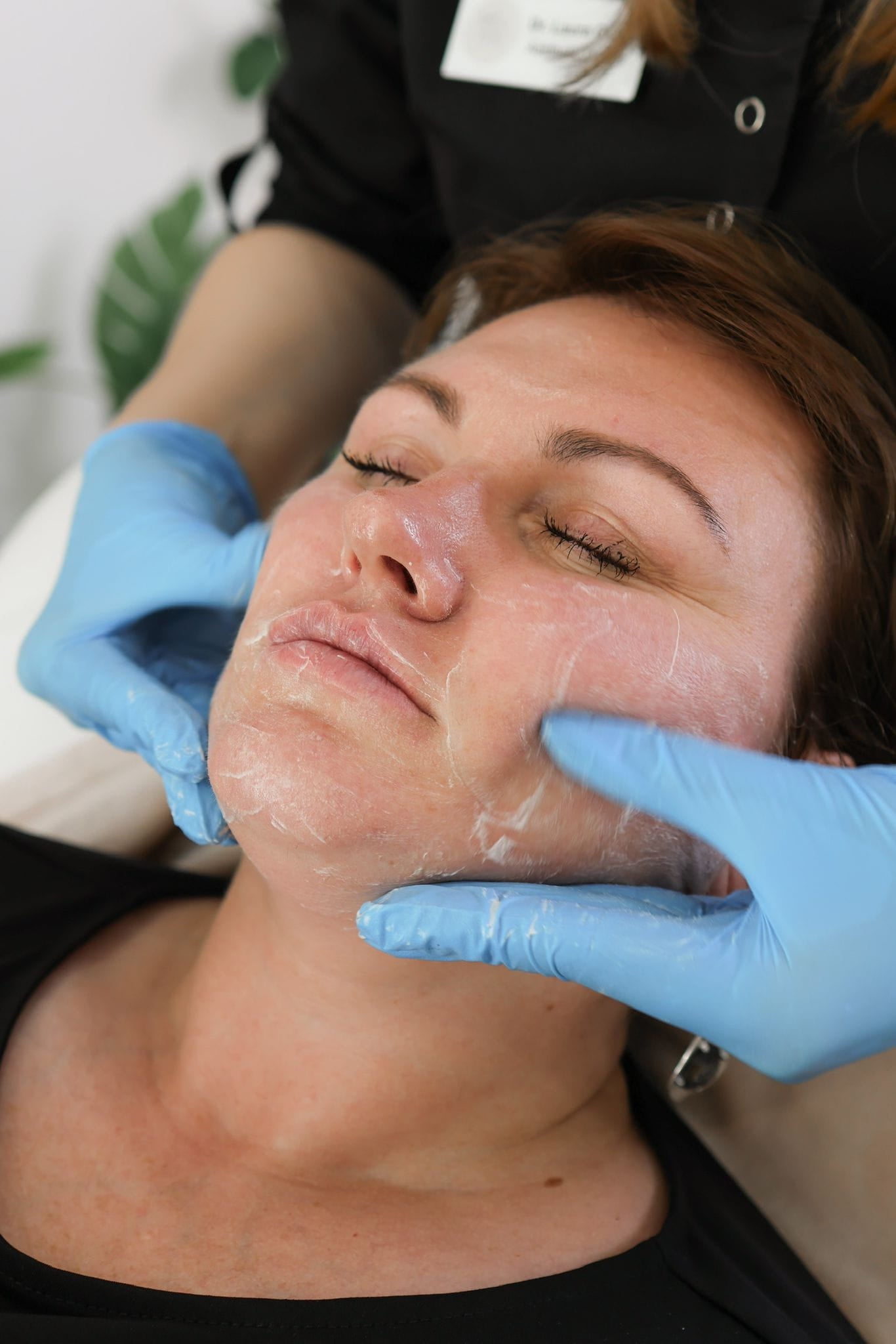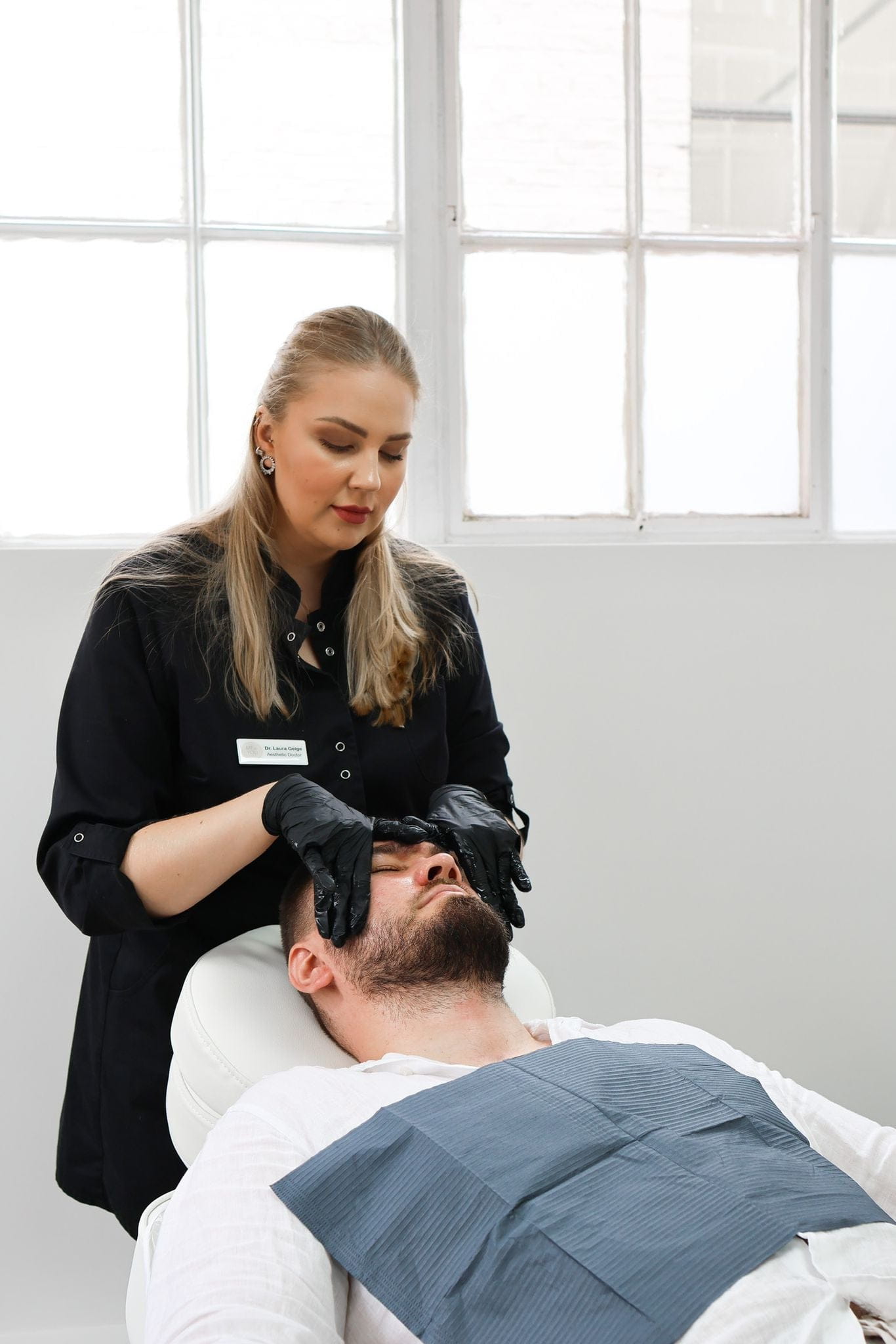How Does Cosmelan Depigmentation Peel Work For Melasma In The UK
Melasma Causes and Symptoms
Melasma is a common skin condition that causes brown or gray-brown patches to appear on the face, often on the forehead, cheeks, nose, and upper lip. These patches are triggered by an overproduction of melanin, the pigment that gives skin its color. Various factors can contribute to melasma, including sun exposure, hormonal changes during pregnancy or while taking birth control, and genetics.

What is Melasma?
Melasma is a common skin condition that causes brown or gray-brown patches to appear on the face. These patches are triggered by an overproduction of melanin, the pigment responsible for skin color.
Several factors can contribute to melasma, including excessive sun exposure, hormonal fluctuations during pregnancy or while using birth control pills, and a family history of the condition. Certain medications and medical conditions may also play a role.
Common Triggers of Melasma
Melasma is a common skin condition that causes brown or gray-brown patches to appear on the face, often on the forehead, cheeks, nose, and upper lip. These patches are triggered by an overproduction of melanin, the pigment responsible for skin color.
Several factors can contribute to melasma, including excessive sun exposure, hormonal fluctuations during pregnancy or while using birth control pills, and a family history of the condition. Certain medications and medical conditions may also play a role.
Here are some common triggers of melasma:
- Sun Exposure
- Hormonal Fluctuations
- Genetics
- Medications
- Medical Conditions
Recognizing Melasma Symptoms
Melasma is characterized by brown or gray-brown patches appearing on the face. These patches are a result of increased melanin production, the pigment responsible for skin color.
Common triggers for melasma include excessive sun exposure, hormonal changes (especially during pregnancy or while using birth control), genetics, certain medications, and underlying medical conditions.
Recognizing melasma symptoms involves looking for these brown or gray-brown patches on the face, often concentrated on the forehead, cheeks, nose, and upper lip. It’s important to note that melasma can appear differently in individuals.
How Cosmelan Works for Melasma Treatment
Cosmelan is a professional peel designed specifically to treat melasma. It works by targeting hyperpigmentation, which is the excessive buildup of melanin responsible for the brown or gray-brown patches characteristic of melasma.
The Active Ingredients in Cosmelan
Cosmelan utilizes a blend of active ingredients to effectively address melasma. A key component is kojic acid, a natural tyrosinase inhibitor that reduces melanin production. Hydroquinone, another potent ingredient, inhibits the enzymatic process responsible for melanin synthesis. Azelaic acid works synergistically with these agents by inhibiting tyrosinase activity and reducing inflammation.
In addition to these core ingredients, Cosmelan incorporates antioxidants like glutathione and vitamin C to protect the skin from oxidative damage caused by free radicals, further promoting a brighter complexion.
Mechanism of Action: Targeting Melanocyte Activity
Cosmelan depigmentation peels work by targeting the activity of melanocytes, the cells responsible for producing melanin.
Melanin is the pigment that gives skin its color, and an overproduction of melanin leads to hyperpigmentation, which manifests as brown or gray-brown patches characteristic of melasma. Cosmelan’s mechanism of action involves multiple steps:
First, it inhibits tyrosinase, the enzyme responsible for melanin synthesis. Ingredients like kojic acid and hydroquinone are effective tyrosinase inhibitors, effectively reducing melanin production.
Second, Cosmelan reduces inflammation within the skin. Azelaic acid, a key ingredient, possesses anti-inflammatory properties that help calm the skin and reduce redness associated with melasma.
Finally, Cosmelan includes antioxidants such as glutathione and vitamin C. These antioxidants protect the skin from free radical damage, which can contribute to pigmentation problems.
Cosmelan Depigmentation Peel Procedure in the UK
Melasma, a common skin condition causing brown or gray-brown patches on the face, is triggered by an overproduction of melanin. Various factors, including sun exposure, hormonal changes, and genetics, can contribute to its development. In the UK, Cosmelan Depigmentation Peel has emerged as a popular treatment option for melasma, offering a potential solution for achieving a more even skin tone.
Preparation for the Treatment
Preparation for a Cosmelan depigmentation peel involves several steps to ensure optimal results and minimize potential side effects. Prior to the treatment, it’s crucial to avoid sun exposure as much as possible. Wear sunscreen daily with an SPF of 30 or higher, even on cloudy days.
It’s also important to discontinue the use of any products containing retinol, acids (such as glycolic acid or salicylic acid), or exfoliants for a period specified by your practitioner. These ingredients can potentially irritate the skin and make it more sensitive during the peel process.
Your practitioner may recommend using specific skincare products leading up to the treatment. These may include gentle cleansers, moisturizers, and sunscreens formulated to protect and prepare your skin.

During your consultation with a qualified practitioner, they will assess your skin type, medical history, and any medications you are taking. They will then provide personalized advice on preparation steps specific to your individual needs.
Treatment Process and Time Involved
The Cosmelan Depigmentation Peel is a professional chemical peel treatment designed specifically for melasma. It utilizes a blend of active ingredients to lighten hyperpigmented skin and restore a more even complexion.
The Cosmelan treatment process typically involves several steps. Initially, your practitioner will cleanse your face and apply the Cosmelan solution. This solution contains a potent mixture of depigmenting agents like kojic acid, hydroquinone, azelaic acid, glutathione, and vitamin C. The peel will be left on for a specific duration determined by your practitioner based on your skin type and the severity of your melasma.
After the allotted time, the Cosmelan solution is neutralized and removed. Your skin may feel slightly sensitive or flushed after the treatment. Your practitioner will provide instructions for post-treatment care, which may include using specialized creams or serums to protect and soothe your skin.
The entire Cosmelan Depigmentation Peel procedure typically takes about 30-60 minutes. Multiple treatments are usually required to achieve optimal results, with sessions spaced several weeks apart. The number of sessions needed varies depending on the individual’s skin condition and response to the treatment.
Post-Treatment Care Instructions
Post-treatment care is crucial for optimizing the results of a Cosmelan Depigmentation Peel and minimizing potential side effects. During the initial few days after the peel, it’s essential to avoid sun exposure as much as possible. Apply sunscreen with an SPF of 30 or higher generously and frequently throughout the day.
Your practitioner will likely prescribe a specialized post-treatment care regimen. This may involve applying soothing creams or serums to keep your skin hydrated and protected from environmental stressors. They might also recommend avoiding certain skincare products, such as exfoliants or retinol-based creams, during this period to prevent irritation or further sensitivity.
It’s important to follow your practitioner’s instructions carefully regarding post-treatment care. Attending any follow-up appointments scheduled by them is crucial for monitoring the progress of your treatment and addressing any concerns you may have.
Benefits of Cosmelan for Melasma Management
Melasma, a common skin concern characterized by brown or gray-brown patches on the face, arises from an overproduction of melanin. Various factors can contribute to melasma development, including sun exposure, hormonal fluctuations, and genetics. Cosmelan is a professional peel designed specifically to address this condition.
Efficacy in Reducing Pigmentation
Cosmelan offers several benefits for managing melasma. It effectively targets hyperpigmentation by inhibiting melanin production through its blend of active ingredients like kojic acid, hydroquinone, and azelaic acid. These ingredients work synergistically to lighten dark patches and promote a more even skin tone.
Cosmelan’s efficacy in reducing pigmentation has been supported by clinical studies and user testimonials. Many individuals experience significant improvement in the appearance of their melasma after undergoing multiple Cosmelan treatments. However, it’s important to note that results may vary depending on individual factors such as skin type, severity of melasma, and adherence to post-treatment care instructions.
Long-Lasting Results with Maintenance Treatments
Cosmelan offers several benefits for managing melasma. It effectively targets hyperpigmentation by inhibiting melanin production through its blend of active ingredients like kojic acid, hydroquinone, and azelaic acid. These ingredients work synergistically to lighten dark patches and promote a more even skin tone.
Cosmelan’s long-lasting results stem from its ability to address the root cause of melasma, which is the overproduction of melanin. By inhibiting tyrosinase, the enzyme responsible for melanin synthesis, Cosmelan helps reduce melanin production at the cellular level.
To maintain these results, individuals often require maintenance treatments. These touch-up sessions help prevent the recurrence of pigmentation and ensure a continued improvement in skin tone.
Skin Tone Improvement and Evenness
Cosmelan is a professional peel designed specifically to treat melasma. It works by targeting hyperpigmentation, which is the excessive buildup of melanin responsible for the brown or gray-brown patches characteristic of melasma.
Here’s how Cosmelan depigmentation peels work:
- Tyrosinase Inhibition: Cosmelan contains potent tyrosinase inhibitors like kojic acid and hydroquinone. Tyrosinase is the enzyme responsible for melanin production. By inhibiting this enzyme, Cosmelan reduces the amount of melanin produced.
- Inflammation Reduction: Azelaic acid, another key ingredient in Cosmelan, possesses anti-inflammatory properties. Inflammation can contribute to hyperpigmentation, so reducing inflammation helps improve the skin’s overall appearance.
- Antioxidant Protection: Cosmelan also includes antioxidants like glutathione and vitamin C. These protect the skin from free radical damage, which can contribute to pigmentation problems.
Cosmelan offers several benefits for managing melasma:
- Effective Pigmentation Reduction: Cosmelan effectively lightens hyperpigmented areas, helping to achieve a more even skin tone.
- Long-lasting Results: By targeting the root cause of melasma (overproduction of melanin), Cosmelan delivers long-lasting results. Maintenance treatments may be required to prevent recurrence.
- Improved Skin Tone and Texture: Beyond treating melasma, Cosmelan can also improve overall skin tone and texture, leaving the skin looking brighter and smoother.
Potential Side Effects and Risks**
Like all medical procedures, Cosmelan Depigmentation Peel carries potential side effects and risks. It’s essential to be aware of these before undergoing treatment. Potential side effects can include temporary redness, dryness, itching, or peeling of the skin. In some cases, more serious side effects such as hypopigmentation (loss of pigmentation) or hyperpigmentation (darkening of the skin) may occur. It’s crucial to discuss your medical history and any medications you are taking with a qualified practitioner before undergoing Cosmelan treatment.
Expected Mild Reactions and Duration
Potential side effects from Cosmelan can include temporary redness, dryness, itching, or peeling of the skin. These are typically mild and resolve within a few days to a week. In some cases, more serious side effects such as hypopigmentation (loss of pigmentation) or hyperpigmentation (darkening of the skin) may occur. It’s important to note that these serious side effects are relatively rare.
The duration of these side effects varies depending on individual sensitivity and treatment intensity. Mild reactions usually subside within a week, while more significant effects may take a few weeks to fully resolve.
Addressing Allergic Reactions or Sensitivity
As with any medical procedure, there are potential risks and side effects associated with Cosmelan Depigmentation Peel. It is crucial to be aware of these before undergoing treatment.
Some individuals may experience allergic reactions or sensitivity to one or more of the ingredients in Cosmelan. These reactions can manifest as redness, itching, swelling, or a rash.
It is important to consult with a qualified practitioner before undergoing any cosmetic procedure, including Cosmelan treatment. They will be able to assess your individual skin type and medical history to determine if Cosmelan is suitable for you and discuss potential risks and side effects in detail.
Choosing a Qualified Practitioner in the UK
When seeking treatment for melasma in the UK, choosing a qualified practitioner is crucial to ensure safe and effective results. Look for practitioners with extensive experience in treating pigmentation disorders, such as dermatologists or registered aesthetic nurses. Verify their credentials and qualifications through professional organizations like the British Association of Dermatologists or the Royal College of Nursing.
Importance of Experience and Expertise
Choosing a qualified practitioner in the UK when seeking treatment for melasma is paramount to ensure safe and effective results.
Experience and expertise are crucial when dealing with pigmentation disorders. Seek practitioners who have extensive experience treating melasma and other skin conditions related to hyperpigmentation. Look for dermatologists or registered aesthetic nurses with proven track records in this area.
Verifying credentials and qualifications is essential. Ensure the practitioner is registered with relevant professional organizations, such as the British Association of Dermatologists (BAD) or the Royal College of Nursing (RCN). These organizations set standards for training and practice, providing assurance of competence and professionalism.
Consultation and Personalized Treatment Plans
Cosmelan depigmentation peels work by targeting the activity of melanocytes, the cells responsible for producing melanin. Melanin is the pigment that gives skin its color, and an overproduction of melanin leads to hyperpigmentation, which manifests as brown or gray-brown patches characteristic of melasma.
Cosmelan’s mechanism of action involves multiple steps:
- Tyrosinase Inhibition: First, it inhibits tyrosinase, the enzyme responsible for melanin synthesis. Ingredients like kojic acid and hydroquinone are effective tyrosinase inhibitors, effectively reducing melanin production.
- Inflammation Reduction: Second, Cosmelan reduces inflammation within the skin. Azelaic acid, a key ingredient, possesses anti-inflammatory properties that help calm the skin and reduce redness associated with melasma.
- Antioxidant Protection: Third, Cosmelan includes antioxidants such as glutathione and vitamin C. These antioxidants protect the skin from free radical damage, which can contribute to pigmentation problems.
Cost Considerations for Cosmelan Treatment
The cost of a Cosmelan Depigmentation Peel in the UK varies depending on several factors, including the practitioner’s experience, location (London typically has higher prices), the number of sessions required, and any additional treatments included. On average, you can expect to pay anywhere from £250 to £600 per session.
Factors Affecting the Final Price
The cost of a Cosmelan Depigmentation Peel in the UK is influenced by several factors:
* **Practitioner’s Experience and Reputation:** More experienced and renowned practitioners often charge higher fees due to their expertise and demand.
* **Location:** Treatment costs tend to be higher in major cities like London compared to other parts of the UK.
* **Number of Sessions:** The number of treatments needed to achieve desired results varies from person to person. Multiple sessions are usually required, increasing the overall cost.
* **Additional Treatments:** Some clinics may offer additional services or products as part of the Cosmelan treatment package, which can affect the total price.
As a general guideline, expect to pay between £250 and £600 per session for a Cosmelan Depigmentation Peel in the UK.
Financing Options Available**
The cost of a Cosmelan Depigmentation Peel in the UK can vary depending on several factors. These include the practitioner’s experience and location, as well as the number of sessions needed to achieve desired results. On average, you can expect to pay between £250 and £600 per session.
Financing options for cosmetic procedures like Cosmelan are becoming increasingly available. Some clinics offer in-house financing plans with flexible payment terms. Others partner with third-party lenders who provide personal loans specifically for medical expenses. It’s best to inquire directly with the clinic you’re considering to learn about their specific financing options.
- How Long Does It Take For Marionette Line Fillers To Settle In London - August 11, 2025
- How Long Do The Results Of A Non-surgical Liquid Facelift Last - August 10, 2025
- How Long After Tear Trough Filler Take To Settle - August 7, 2025
